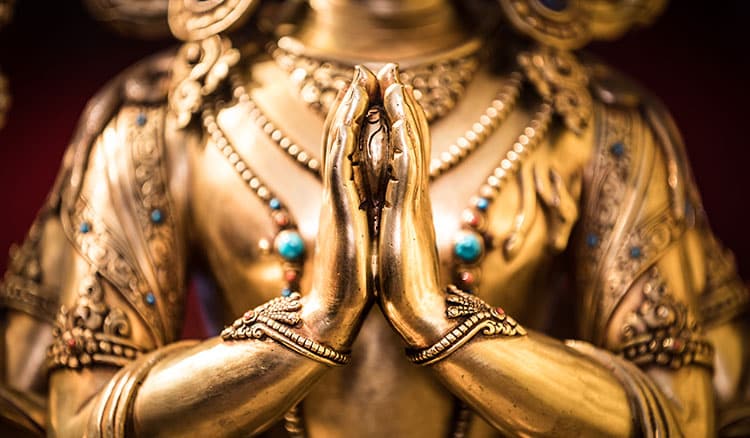What Does it Mean to Take Refuge?
Category: Buddhist Path

Taking Refuge in the 3 Jewels Of Buddhism
When we’re suffering, it’s natural to try and seek refuge, or shelter from our pain. Until we’ve found a spiritual path, we might seek refuge in medication, therapy, material objects, food, other people, or in particular places. None of these things, however, is capable of offering us lasting freedom from our pain, as all of these things are changing and impermanent.
Buddhists take refuge not in people, places and things, but in the 3 jewels of Buddha, Dharma and Sangha. To ‘take refuge’ may refer to the formal, ceremonial act of becoming Buddhist by taking the refuge vows. In other contexts, it may refer to anyone who has chosen to put their healing in the hands of a spiritual path or higher power, versus seeking relief in worldly objects.
What it Means to Take Refuge
A refuge is a shelter, a safe place that protects us from danger. The ultimate danger we face on a daily basis is the impermanence of being human, our inevitable death. We wrestle with our fear of this reality in smaller ways, each and every day. In the process, we experience pain and suffering.
Without a spiritual path to turn to, we seek to alleviate our suffering through worldly means. But in turning to impermanent solutions, we only find more suffering. To take refuge is to finally admit the hopelessness of this unsatisfactory approach. We come for shelter when we understand, through our experience, that the mundane, no matter how hard we try, cannot and does not offer us lasting solutions.
Having realized we’ve been lost and confused, we look toward a spiritual solution. We might try different styles of meditation, practice yoga, or pick up a book on religion. But even spirituality is of little use to us if we’re continually shopping around, picking and choosing only the pieces we enjoy from one religion or another.
To take refuge is to commit to walking a single path and following it to the end. We vow to work on ourselves “without sidetracks or exits,” as the great Tibetan Master Chogyam Trungpa Rinpoche once put it. This promise to deeply explore one single method of training the mind is not an easy one, but necessary if our work is to be full and whole and complete.
The 3 jewels of Buddhism are the Buddha, the Dharma and the Sangha. These three are referred to as jewels because each is an immeasurably valuable part of the Buddhist path.
The Buddha Jewel
The Buddha is not meant to be lauded as a God or savior, but as a fellow human being. Just like us, the Buddha was human. By committing himself to meditation practice, he realized total freedom from his suffering. The essence of his 40-years of teachings is that we too, can do the same. To take refuge in the Buddha jewel is to understand that as human beings, we have the exact same potential for enlightenment that the Buddha did—we can discover our own Buddha nature.
The Dharma Jewel
The Dharma represents the vast thousands-year old teachings of the Buddha, which offer us a roadmap to follow along the path. These include ancient texts and the teachings from more recent meditation masters and lineage holders, but also, every single thing that happens in our lives. Having taken refuge in the Dharma, reality itself becomes our greatest teacher. If we see everything as an opportunity for learning and growth, everything we experience becomes usable on our path toward freedom.
The Sangha Jewel
The Sangha refers to our companions along the path. Traditionally, the noble Sangha is comprised of monastics, bodhisattvas and other enlightened beings. The Sangha can also be understood as the community of like minded others who, just like us, are awake to their pain and the futility of worldly solutions, and are open to taking a different path. The Sangha offers us support and inspiration, and serves as a mirror through which we may receive feedback about our progress along the path.
Taking Refuge as an Ongoing Process
To take refuge is not to simply join a club, become passively transformed, or to receive a magic blessing that absolves us from action or responsibility. It’s a commitment to let go of old habits and continually work toward becoming the most wise and compassionate versions of ourselves, so that we can better help all others.
Doing this inner work is an ongoing process that does not end with taking refuge, but begins in earnest with the refuge vow. With the Buddha and all other enlightened beings as our example, with the support of a community of fellow practitioners, we turn toward the work of getting to know our own minds by studying the Dharma and applying the teachings to each and every aspect of our daily lives.
Because the work takes place within our own bodies and minds, in a very real sense we each take refuge in our own awareness. Anyone who turns to meditation and works genuinely with their own mind as a solution to their pain, doing this over and over again as new challenges arise, is participating in the act of taking refuge.








